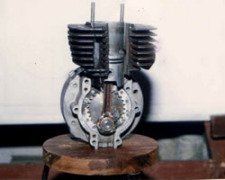Conversion of circular motion to reciprocating motion & vice versa
Mr. Joshua Devathathan, 50 years, is a Christian Pastor. Though he is not an engineer by profession but he has a strong bent of mind towards mechanics.
Conversion of Circular Motion To Reciprocating Motion & Vice Versa:
For many years research engineers in the field of Mechanical Engineering have been trying to find an alternative for the SLIDER CRANK mechanism. It is only the conversions of reciprocate motion to circular motion and vice versa. This innovation replaces the slider crank mechanism, which works on the principle of hypocycloid. This mechanism consists of a set of internal gears. The power-transmitting end of the connecting rod does not move in a circular motion. But travels vertically up and down or horizontally back and forth side ways.
This mechanism consists of a set of internal gears; one spur gear, which revolves within a directing gear whose teeth are cut internally, which, is fixed firmly to the casing. One end of connecting rod is fixed to a crank pin; so as to enable the pin to revolve freely and in turn is fixed firmly overlapping the small gear (spur gear) at eccentrics. The small gear is firmly fixed to a shaft that freely revolves in a circular disc, which is attached to the main shaft. When the connecting rod moves up & down vertically, the crank pin also moves in the same direction, without any side ways movement as in the slider crank mechanism and the spur gear revolves freely within the directing gear driving the disc in a circular motion.
The power-transmitting end of the connecting rod does not move in a circular motion. But travels vertically up and down or horizontally back and forth side ways. The loss of power due to side thrust caused by slider crank mechanism is reduced, resulting in increased efficiency.
It can be applied in lathes, pumps, saws, etc.








